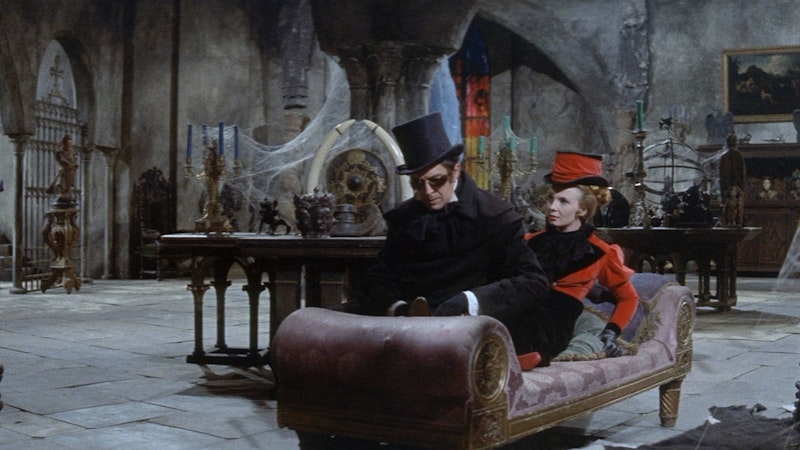Roger Corman’s 1964 film The Masque of the Red Death is spectacular, but on its release didn’t make very much money for American International Pictures. AIP asked Corman to do one more Poe adaptation, and later in 1964 he made The Tomb of Ligeia. It again didn’t pull the box-office figures Corman’s previous seven Poe movies had and was the last of the cycle. It’s widely regarded as among the better entries in the series, and Corman agreed, but for me it shows signs of strain.
The film opens with the funeral of a beautiful woman, Ligeia, whose widower, Verdon Fell (Vincent Price) soon meets a woman who looks disturbingly like his dead wife: Rowena (Elizabeth Shepherd, in a dual role). Sprightly and energetic, Rowena nevertheless falls for the morbid Fell, who due to an eye condition always wears dark tinted glasses. Fell believes he’s haunted by his dead wife, who thought her will was strong enough to conquer death. A mysterious cat roams the crumbling former abbey that’s his home, and he may be slipping into madness. It all builds to an inflammatory climax.
Corman didn’t want to use Price for the lead, which he viewed as a more romantic role than fit Price’s age (53 in 1964). AIP forced him, though, so he caked Price in makeup, put a wig on him, and hid him behind those glasses. It almost works, in a gothic way: the bright young Rowena drawn, for some reason, to the older, deader, dryer villain. The problem is that the film needs some uncertainty about Fell, some reason to think he’s not a brooding villain. Price does his best, but he’s not the right actor for the part.
It doesn’t help that the actors around him are doing something different than he is. There’s a subtle contrast between Price’s traditional Hollywood acting and the technique of the rest of the largely-British cast. For the first time in Corman’s Poe films Price is almost overshadowed by his leading lady. That’s narratively emphasized because while in Corman’s previous Poe adaptations we often saw a lone stranger coming to a weird old house ruled by Vincent Price, here Price is relatively isolated while Rowena has a father and a former fiancé, Christopher (John Westbrook).
Made in the UK as part of a deal AIP struck with a British studio, Ligeia also uses exterior shots of an actual abbey. That means there’s a striking contrast between the photography of the abbey exteriors and that of the interiors, shot with the kind of lighting and filled with the kind of knick-knacks we see in Corman’s earlier Poe films. The artificial worlds of the earlier movies become disconcertingly real, as Price and Rowena wander around outside. Then they pass through a doorway, and by the magic of cinema we’re back in a studio on an obvious set. Both outside and inside look fine, but they don’t look like parts of the same whole.
The script, by a young Robert Towne, doesn’t reflect the visual contrast. In some ways it’s a step down from the other films; certainly it has one of the most notorious lines: “not 10 minutes ago I... I tried to kill a stray cat with a cabbage, and all but made love to the Lady Rowena. I succeeded in squashing the cabbage and badly frightening the lady. If only I could lay open my own brain as easily as I did that vegetable, what rot would be freed from its grey leaves?” Price delivers it with no irony, and nearly makes it work. But nobody else plays to the material in quite the same way, delivering instead a matter-of-factness that perhaps looks forward to folk-horror like The Wicker Man rather than back to the Universal horror films.
It’s not a bad movie. The exteriors do give a visual richness unlike the other Poe movies. And Fell’s ruined abbey comes alive, mismatched parts and all, as another of the morbid gothic mansions of the Poe cycle. The linkage of Ligeia’s spirit to the architecture of the place works, suggesting a haunted house with an only partially-manifesting ghost. Here as elsewhere in Corman’s Poe films, the real monster is psychology, and the only-partially-repressed dread of necrophilia is more overt than the dread of incest in The House of Usher. Only four years have given Corman new freedoms to explore.
It’s tempting to see the destruction of the abbey at the end as symbolizing in some way the end of the Poe cycle. That’d be wrong. Corman was bringing personal concerns to commercial filmmaking, and doing a good job of it, but wasn’t creating a consciously-shaped series. Almost every film ends with the destruction of a massive edifice, or the death of Price, or both at once. Everything’s annihilated at the end of one film and is reborn for the start of the next.
But if you watch through the eight Poe films, there’s a sense of gravity and finality about Ligeia. It looks and feels different from the other movies. Other ways of filmmaking are crashing in on the isolated artificial settings. In only four years approaches to making budget-conscious horror films had changed. Corman’s Poe films could only have been made in the moment they were, when audiences were prepared to accept the conventions they used. They’re good enough to make the conventions work, though, even for viewers not born when they first came out. Like all good horror movies, they never die, but remain, undead, haunting the respectable canon of film art with things that can’t be said in any other way.

